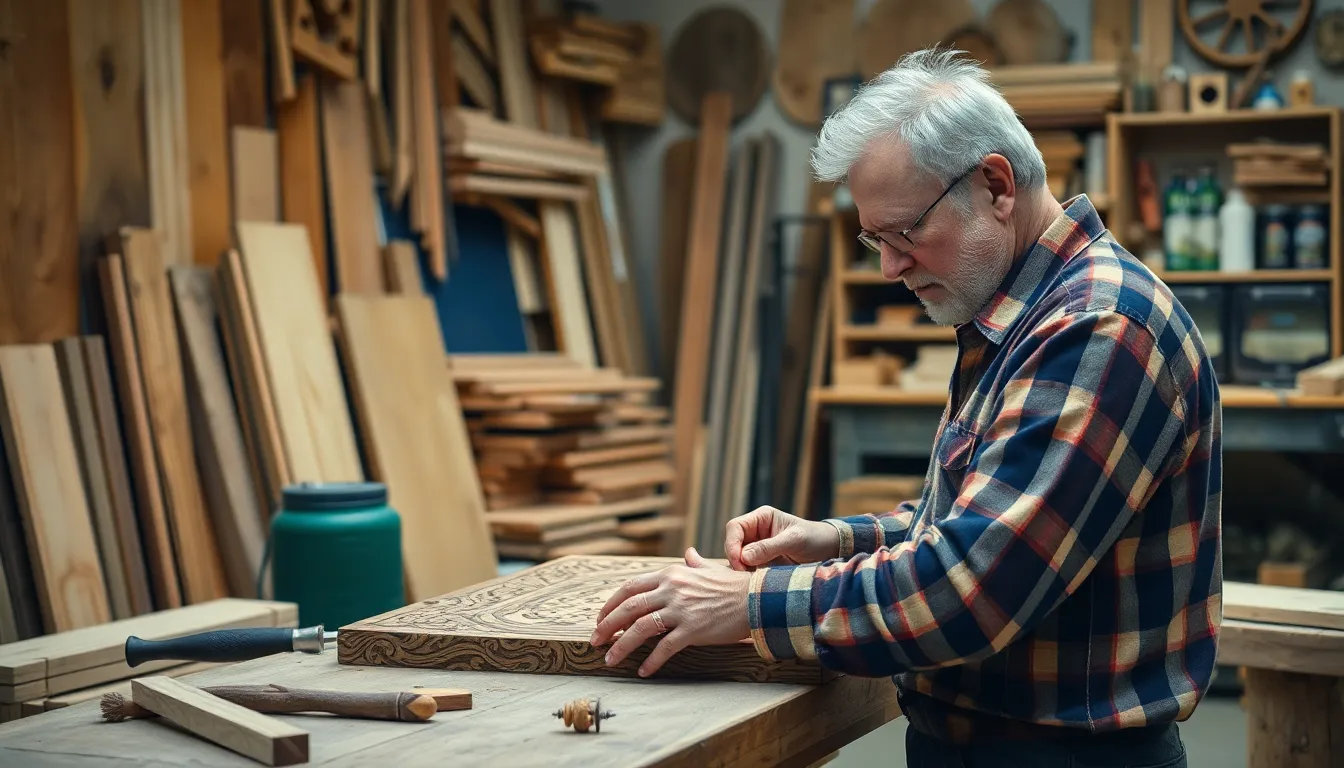Table of Contents
ToggleWoodwork designs have a unique charm that can transform any space from drab to fab faster than you can say “measure twice, cut once.” Whether it’s a rustic coffee table that makes your living room feel like a cozy cabin or sleek shelves that scream modern chic, the right woodwork can elevate your home’s aesthetic. It’s not just about functionality; it’s about crafting a statement that reflects personality and style.
Overview of Woodwork Designs
Woodwork designs showcase creativity and craftsmanship, providing both beauty and utility in various settings. Traditional styles feature ornate carvings and intricate detailing, while contemporary designs emphasize sleek lines and minimalism. A variety of wood types, such as oak, maple, and walnut, contribute to the unique character of each piece.
Functionality plays a crucial role in these designs, with furniture and decor serving practical purposes. For instance, custom cabinetry optimizes storage space, while artistic sculptures function as focal points in a room. Designers often incorporate ergonomic considerations, ensuring comfort without sacrificing aesthetics.
Sustainability influences selection, with an increased focus on responsibly sourced materials. Those opting for eco-friendly woodwork support environmentally conscious practices, contributing to a healthier planet. Techniques such as reclaimed wood usage highlight the trend toward sustainable design.
Texture and finish enhance the tactile experience of woodwork. Various stains, paints, and finishes allow personalization, while natural wood grains bring warmth into spaces. Designers frequently experiment with mixed media, combining metal, glass, or textile elements for an innovative touch.
Finally, woodwork designs frequently respond to current trends. Popular motifs include vintage retro styles, Scandinavian simplicity, and industrial ruggedness. A keen understanding of these trends helps designers craft pieces that resonate with contemporary aesthetics, ensuring relevance and appeal.
Types of Woodwork Designs

Woodwork designs offer diverse styles to suit various preferences and needs. Each design category reflects unique characteristics and craftsmanship.
Traditional Woodwork Designs
Traditional woodwork designs showcase intricate details and classic aesthetics. Ornate carvings often adorn furniture and decor, highlighting skilled artisanship. Commonly used wood types include oak and mahogany, enhancing the timeless appeal of pieces. Styles such as Victorian and colonial often draw inspiration from historical influences. These designs frequently incorporate elaborate moldings, providing depth and character to interiors.
Modern Woodwork Designs
Modern woodwork designs emphasize clean lines and minimalist forms. Often featuring sleek surfaces, this style promotes functionality while minimizing clutter. Wood types like plywood and engineered wood are popular for achieving contemporary looks. Innovative techniques, such as lamination and bending, create unique shapes and structures. The focus on sustainability leads to eco-friendly materials that blend seamlessly with modern aesthetics.
Rustic Woodwork Designs
Rustic woodwork designs evoke warmth and a natural charm. Reclaimed wood and rough finishes contribute to the earthy appeal. Pieces often include farmhouse tables and log cabin furniture, bringing an authentic, cozy atmosphere. Textured surfaces and organic shapes enhance the connection to nature. The use of local woods adds character and ensures sustainability, making rustic designs both inviting and environmentally conscious.
Essential Tools and Materials
Effective woodwork designs require specific tools and materials for successful execution. A solid foundation in tools enhances craftsmanship and creativity.
Tools Needed for Woodwork Designs
Essential tools include a saw for cutting wood into desired shapes, a chisel for detailing, and a hammer for joining pieces. Saws come in various types, like circular and jigsaw, each suited for different tasks. Drill and drill bits accommodate various sizes of screws and holes, providing versatility. Measuring tools such as squares, calipers, and tape measures ensure precision. Sanding tools, including sandpaper and power sanders, create smooth surfaces. Clamps secure materials during assembly, preventing unwanted movement. Additionally, a workbench offers a stable surface for projects.
Best Wood Types for Carpentry
Selecting appropriate wood types significantly influences the final design. Hardwoods, such as oak, provide durability and a rich finish, making them popular for furniture. Maple offers a light aesthetic and is perfect for modern designs. Walnut delivers a deep color, enhancing luxury in various pieces. Softwoods, such as pine, are ideal for projects focused on budget and ease of use. Cedar is favored for outdoor furniture due to its natural resistance to decay. Reclaimed wood stands out for its unique history and eco-friendly appeal. Each wood type contributes distinct characteristics to woodwork, ensuring tailored outcomes.
Tips for Creating Unique Woodwork Designs
Utilize sketches to visualize ideas before starting projects. Planning the layout ensures each piece fits cohesively within the desired space.
Incorporate various wood types to achieve distinct effects. Pairing hardwoods like oak with softwoods like pine enhances visual interest and adds depth to designs.
Experiment with different finishes to create unique looks. Stains and paints can transform the character of the wood, allowing for personal expression and style.
Draw inspiration from current trends while adding personal touches. Incorporating elements of Scandinavian simplicity or industrial ruggedness with a unique twist keeps designs fresh.
Consider functionality to balance style and utility. Custom cabinetry can provide optimized storage solutions while incorporating artistic flair through thoughtful design.
Seek out reclaimed wood to infuse historical charm into projects. Each reclaimed piece tells a story, making it an appealing choice for distinctive woodwork designs.
Understand the importance of scale in creating visual harmony. Ensure each design element balances well with existing furniture and decor for a cohesive look.
Collaborate with other artisans to enhance creativity and explore new techniques. Sharing expertise and skills can lead to innovative designs that reflect collective craftsmanship.
Finalize with precision by utilizing quality tools. Saws, chisels, and drills can significantly impact craftsmanship and ensure smooth execution of designs.
Woodwork designs offer a remarkable way to enhance any living space while reflecting individual style. By blending artistry with functionality, these pieces not only serve practical purposes but also elevate the aesthetic appeal of a home. Whether one prefers the intricate details of traditional designs or the sleek simplicity of modern styles, there’s a woodwork option for every taste.
Sustainability remains a vital consideration in today’s designs, with an increasing emphasis on responsibly sourced materials. The versatility of wood types and finishes allows for endless creativity, ensuring that each piece is as unique as its creator. Embracing woodwork as a form of personal expression can lead to stunning results that resonate with both contemporary trends and timeless charm.










